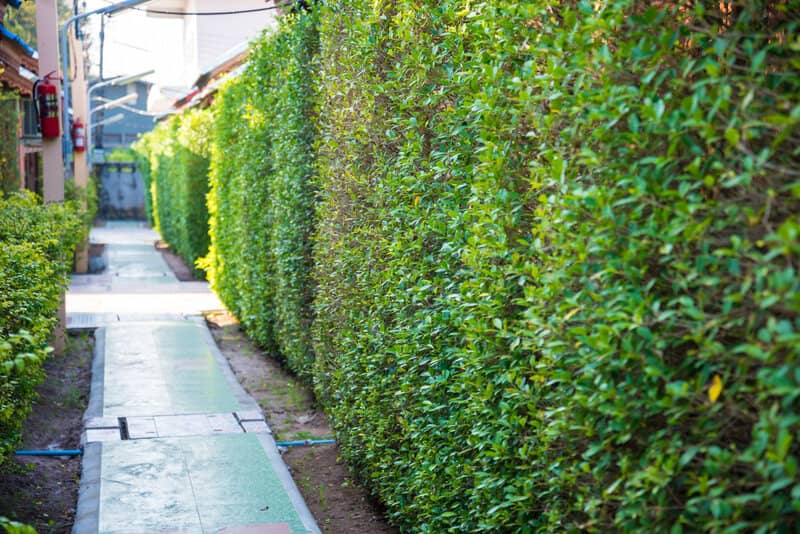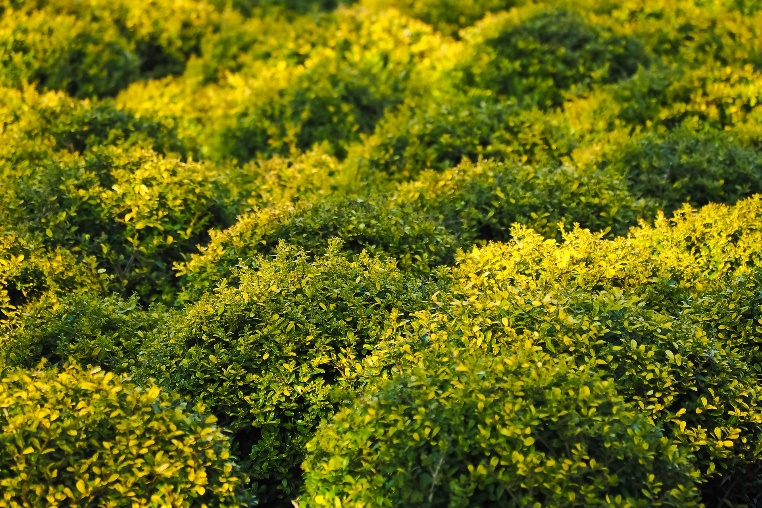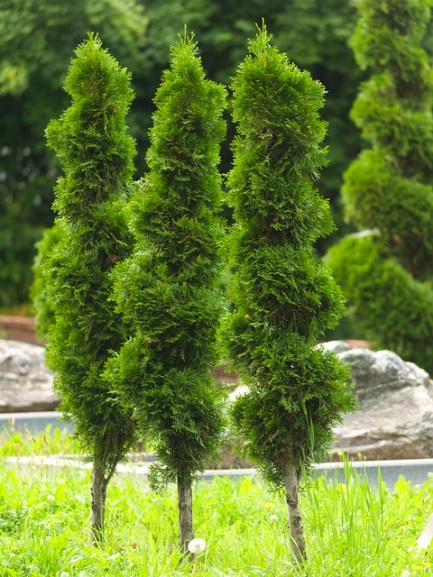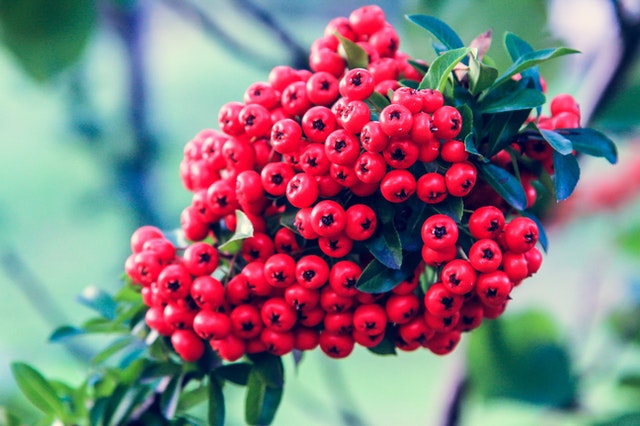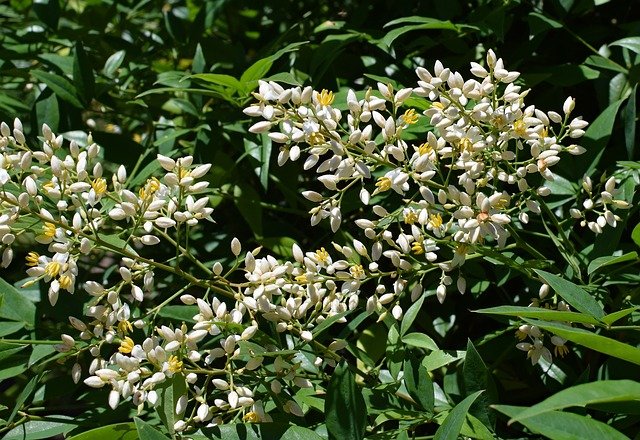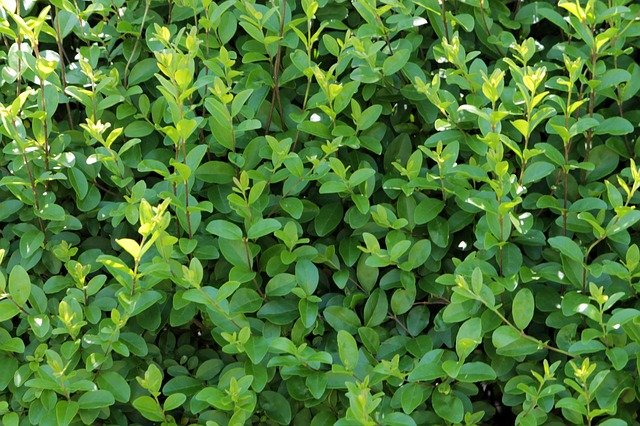Evergreens are best if you love the privacy and want to repel noise or air pollution.
These shrubs and trees create a significant barrier between your property and the outside world, which works better than fences.
Some develop into dense hedges within a few weeks, while others grow.
Look at the UK’s top 10 evergreens for privacy screens and hedges.
Pick a couple because planting more than one variety in your garden is better.
Producing more than one version of shrubs ensures none of the pests or diseases can destroy all of them at once.
If you plan a privacy screen, do not plant the evergreens in a straight line.
Instead, plant them in a zig-zag manner to receive sufficient sunlight and air. Such an arrangement also prevents breakage.
UK’s Best Evergreens for Privacy Screens and Hedges
1. Boxwood (Buxus)
One of the European gardeners’ favourites is that boxwood is very responsive to trimming, shaping or pruning.
This shrub has tiny leaves that look stylish and trendy once you clip them. Hence, it makes excellent hedges and is also suitable for topiary.
Korean boxwood is more demanding than its English variants.
Depending on the variety, it can develop well in partial shade and full sun. It’s better to prune them in the late spring when the new growth darkens.
- USDA Growing Zones: 6 to 8
- Sunlight requirements: Full or partial sun 6.8 to 7.5
- Preferred soil: Well-drained with a pH level between
2. Yew (Taxus baccata)
If you need a dense hedge highly responsive to pruning, try yew in your garden. It’s easy to restore with an electric trimmer or hand shears. You can also use this tree for foundation plantation because it remains squat.
Taxus baccata or yews grows up to 6 feet and spreads around 6 feet. This height and width look excellent when used as hedges. Often, yew grows uniformly and makes an ideal fence for enclosed yards. Its development could be faster to medium, depending upon the variety.
- USDA Growing Zones: 2 to 10, as per the species
- Colours: Dark green needles and red berries, no flowers
- Sunlight requirements: Full or partial shade, full sun, depending upon the version
- Preferred soil: Well-draining with neutral pH
3. Arborvitae Green Giant (Thuja Green Giant)
U.S. National Arboretum is the reason why Arborvitae Green Giant came into existence. This evergreen tree can develop in almost any condition. So, you can try it on sand and clay soils.
Arborvitae grows into a shape of a pyramid, which looks great on your property.
Here comes the great news.
This green giant does not need any pruning. Plus, it’s both pest and deer resistant. Arborvitae looks excellent when you plant them 5 to 6 feet apart. If you want a gradual hedge, you prefer a distance of 10 or 12 feet. You will like that this is a fast-growing tree and reaches around 60 feet in height. Its spread is roughly about 20 feet.
- USDA Growing Zones: 2 to 7
- Sunlight requirements: Partial or complete sun
- Preferred soil: Well-drained, moist soil, but can tolerate a variety of conditions
4. Holly (Ilex)
Glossy leaves and bright red berries are why Holly looks great in any garden. Only females can produce berries, but they need males for cross-pollination. However, some new varieties do not require both sexes.
Holly grows well in acidic soil. It might need garden sulfur or peat to develop. English Holly does good in all the conditions, but the American variant is more adaptable. This medium-growing plant reaches a maximum height of 6 to 10 feet. Its spread varies between 5 to 8 feet. We recommend that you plant Holly plants 2 to 4 feet apart.
- USDA Growing Zones: 5 to 9
- Colours: Red berries and greenish-white flowers
- Sunlight requirements: Partial to full sun
- Preferred soil: Fertile, well-drained and slightly acidic
5. Firethorn (Pyracantha coccinea)
Sometimes behaves like an undisciplined kid, but Firethorn looks strikingly attractive in your garden. This evergreen grows orange-red berries in summer and early winter. In spring, it looks beautiful with white flowers.
Firethorn is widely used in Christmas decorations. It grows fast and reaches up to 8 to 12 feet. The spread varies between 3 to 5 feet. Prune these plants only after flowering.
- USDA Growing Zones: 6 to 9
- Colours: White flowers convert into orange fruits
- Sunlight requirements: Partial to full sun
- Preferred soil: Well-drained and moist
6. Leyland Cypress (x Cupressocyparis Leylandii)
A column-like plant with flat foliage, Leyland Cypress is one of the best wind or privacy screen options. Full sun is best for its development. Some new Leyland cypresses are grown because of their feathery foliage, variegation and attractive blue appearance.
Leyland cypress grows fast and can reach a maximum height varying between 60 to 70 feet. Its spread could be anywhere between 15 to 20 feet. Once you prune this tree, its new leaves deepen in colour.
- USDA Growing Zones: 6 to 10
- Colours: White
- Sunlight requirements: Partial to full sun
- Preferred soil: Neutral clay or acidic, sand and loam
7. Variegated Japanese Laurel (Aucuba japonica)
A gold dust tree or Variegata looks attractive because of its green leaves with some hints of yellow. Due to its beautiful appearance, this one can quickly light up a monotonous spot in your garden. You might understand with its name, Variegata is a female plant that needs males for cross-pollination.
Maculata and Mr Goldstrike are high-quality choices if you like Variegated Japanese Laurel. This evergreen can develop up to a height of 9 feet with a spread of a maximum of 5 feet. It grows well in moist soil but doesn’t disappoint during dry spells. Laurel grows slowly so that you can prune it in the early spring or summer.
- USDA Growing Zones: 7 to 10
- Colour Varieties: Red berries, green leaves with gold spots
- Sun Exposure: Partial to full sun
- Soil Needs: Well-drained
-
Cotoneaster (C. lucidus, C. glaucophyllus, C. franchetii)
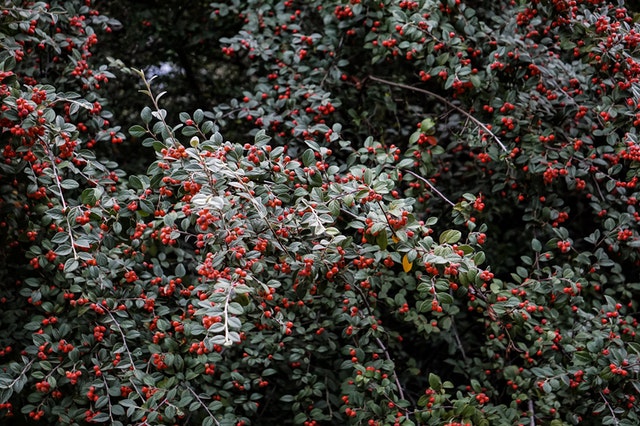
Similarly, C. glaucophyllus has a length of 3 to 4 feet. Its spread is around 6 feet. If you need longer shrubs, try C. franchetii that can grow up to 6 feet. Plus, its spread is also around 6feet, which is perfect if you want some privacy screens.
- USDA Growing Zones: 5 to 9, depending upon the version
- Colour Varieties: Bright leaves and red barriers in the fall
- Sun Exposure: Partial to full sun
- Soil Needs: Well-drained, loamy and moist
-
Heavenly Bamboo (Nandina Domestica)
Nandina domestics is very popular in the North USA because of its striking berries in the fall and winters. Before the berries, heavenly bamboo produces white flowers.
This evergreen has delicate leaves, but it’s tough and can survive easily in challenging conditions.
The evergreen’s foliage converts into red in fall and winters. It is a medium and sometimes fast grower. So, prune this shrub before its new growths.
- USDA Growing Zones: 5 to 10
- Colour Varieties: White or sometimes pinkish florets, red berries
- Sunlight requirements: Partial
- Preferred soil: Acidic and rich
-
Privet (Ligustrum)
If you need a classic and efficient hedge plant, then try Privet. However, keep in mind that all the privets are not evergreen.
These popular shrubs are very responsive to pruning, which you can perform right after its flowering.
Most of the privets produce white flowers in the summers. Then, these plants generate blackberries.
You will like the fact that privets are highly adaptable and can grow well in any condition. They develop from full sun to partial shade.
They grow fast and have a maximum height of 15 feet and a spread of around 6 feet.
- USDA Growing Zones: 3 to 8
- Colour Varieties: White florets and blackberries
- Sunlight requirements: Partial or complete sun
- Preferred soil: Can withstand a wide range of soils
FAQs
What is a hedge?
A living wall that you can alternate to a fence or boundary is called a hedge. Plant some shrubs or trees into a row to form such a structure on your property. It serves the following purposes:
- A hedge defines your garden.
- It works as a boundary or property marker.
- These plants stop all the noise from neighbours or a nearby street.
- Provides privacy from passers-by
- Covers a view that might not look great to your outsiders
- It serves as a windbreak and saves a lot on house heating costs in the winters.
Where should you plant a hedge or privacy screen?
The location depends on your requirements. For instance, if you need a windbreak, create the hedges on the north or northwest part of your house so that they can block the harsh winter winds. On the other hand, plant the barriers between your residence and the street if you want them to works as a privacy screen.
Review the environment and conditions while planning the hedge location. You can add these privacy screens anywhere, but they need proper sunlight, air and water to survive. Hence, it’s better to consider the plant species that you want to include.
All the shrubs or trees need some space to grow – both in height and width. So, check for overhead wires or other large trees and not plant them very close to a structure.
How tall should a hedge be?
The height is essential if you need a privacy screen, which can block the view. The evergreens and other trees differ when it comes to size and width. We have already told you some of the best options for hedges or privacy fences. So, use a stepladder where you want a wall and imagine how tall it has to be. Afterwards, choose a suitable species from the options mentioned above.
Final thoughts
Now you know some of the best evergreens for privacy screens and hedges. A few of these plants grow fast, but others are a little slower.
It’s essential to create a privacy screen with mixed species. Plant them in clusters of 3 to 5, either in a single straight line or zig-zag, depending upon the conditions.
Mixed plantations make sure none of the diseases or pests is transferred from one plant to others. Plus, your hedge looks great throughout the year due to variable growth rates. Happy gardening.

